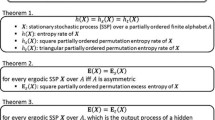
Overview
- Includes supplementary material: sn.pub/extras
Part of the book series: Springer Series in Synergetics (SSSYN)
Access this book
Tax calculation will be finalised at checkout
Other ways to access
About this book
The study of permutation complexity can be envisioned as a new kind of symbolic dynamics whose basic blocks are ordinal patterns, that is, permutations defined by the order relations among points in the orbits of dynamical systems.
Since its inception in 2002 the concept of permutation entropy has sparked a new branch of research in particular regarding the time series analysis of dynamical systems that capitalizes on the order structure of the state space. Indeed, on one hand ordinal patterns and periodic points are closely related, yet ordinal patterns are amenable to numerical methods, while periodicity is not.
Another interesting feature is that since it can be shown that random (unconstrained) dynamics has no forbidden patterns with probability one, their existence can be used as a fingerprint to identify any deterministic origin of orbit generation.
This book is primarily addressed to researchers working in the field of nonlinear dynamics and complex systems, yet will also be suitable for graduate students interested in these subjects. The presentation is a compromise between mathematical rigor and pedagogical approach. Accordingly, some of the more mathematical background needed for more in depth understanding has been shifted into the appendices.
Similar content being viewed by others
Keywords
Table of contents (11 chapters)
-
Front Matter
-
Back Matter
Reviews
From the reviews:
“This book describes a study of permutation complexity … . The book is aimed primarily at researchers in nonlinear dynamics and complex systems, but it is also accessible to graduate students.” (William J. Satzer jun, Zentralblatt MATH, Vol. 1197, 2010)Authors and Affiliations
Bibliographic Information
Book Title: Permutation Complexity in Dynamical Systems
Book Subtitle: Ordinal Patterns, Permutation Entropy and All That
Authors: José Amigó
Series Title: Springer Series in Synergetics
DOI: https://doi.org/10.1007/978-3-642-04084-9
Publisher: Springer Berlin, Heidelberg
eBook Packages: Physics and Astronomy, Physics and Astronomy (R0)
Copyright Information: Springer-Verlag Berlin Heidelberg 2010
Hardcover ISBN: 978-3-642-04083-2Published: 15 March 2010
Softcover ISBN: 978-3-642-26289-0Published: 04 May 2012
eBook ISBN: 978-3-642-04084-9Published: 20 March 2010
Series ISSN: 0172-7389
Series E-ISSN: 2198-333X
Edition Number: 1
Number of Pages: X, 280
Number of Illustrations: 13 illustrations in colour
Topics: Complex Systems, Mathematical Methods in Physics, Data Structures and Information Theory, Applications of Mathematics, Statistical Physics and Dynamical Systems



